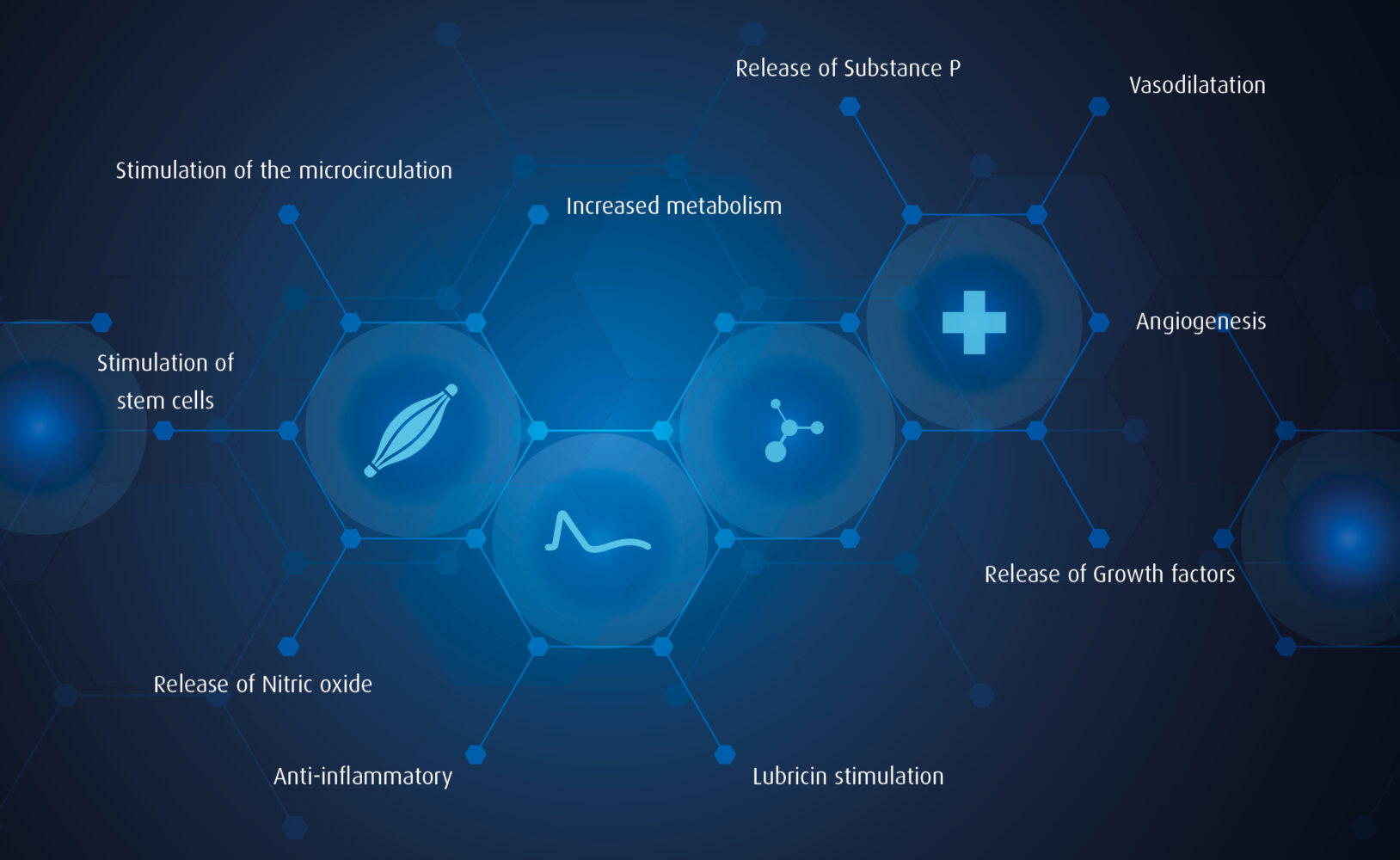Extracorporeal Shockwave Therapy
Perform Better with Shockwave Therapy!
Men’s Sexual Health
Musculoskeletal System
Erectile Dysfunction (ED)
Do you suffer from inability to maintain an erection or get an erection due to lack of blood flow? Let Low intensity extracorporeal shockwave therapy (LI-ESWT) help with neovascularization (new blood vessel regeneration), particularly in promoting more blood flow to help you achieve better erection!
Peyronie Disease (PD)
Do you experience penile pain, curvature, and/or ED? Low intensity extracorporeal shockwave therapy (LI-ESWT) can help with penile pain reduction; furthermore, prevent disease progression.
Musculoskeletal Conditions
Whether it’s from the day to day ergonomics or previous car accident or sports injuries. Following an event, the body makes an effort to repair itself, but sometimes incompletely. Consequently leaving you with residual pains and aches.
For example, shockwave therapy can be helpful for the following conditions:
- Tennis elbow / Golfer’s elbow
- Frozen shoulder
- Trigger point treatment
- Achilles tendinopathy
- Plantar fasciitis
- and more!
Chronic Pelvic Pain Syndrome (CPPS)
CPPS is usually diagnosed if pelvic pain persists without an infection. Generally, symptoms can be pain the perianal region and/or include problems with voiding. Low intensity extracorporeal shockwave therapy (LI-ESWT) has shown improvements in pain, urinary score, quality of life, and National Institutes of Health-developed Chronic Prostatitis Symptom Index (NIH-CPSI) score.
Why You Need Shockwave Therapy
Male sexual dysfunction is a common systemic disorder that increases with age. In fact, there are many components involved in maintenance of normal male sexual functions: vascular, neurological, hormonal, and psychological.
Some major conditions of male sexual function include erectile dysfunction (ED), Peyronie’s disease (PD), decreased libido, and ejaculatory disorders.
Erectile Dysfunction (ED)
There are many causes to ED, including cardiovascular disease (CVD), diabetes, hypertension, obesity, high cholesterol, smoking, and certain medication use. As such, many experts pair CVD along with ED because they share many risk factors. For this reason, either conditions can be predictors of the other condition. In fact, if treatments has to be geared towards treating CVD, otherwise the outlook of ED treatments will not be optimal.
Peyronie’s disease (PD)
PD often present as having penile pain, curvature, shortening, scar tissue/hard plaques, and/or sexual dysfunction. However, the cause to PD is not completely well understood, but generally revolve around combinations of physical trauma, connective tissue disorder, and heredity.
Although PD appears to be more physical in presentation, it may still result in stress and anxiety, which further contributes to psychological sexual dysfunction. Concurrently, there are many treatment options as well as surgery that have shown to be effective for PD. Hence, we focus on reducing mean plaque size, reduction of pain, and prevent progression of the disease.
Decreased Libido
In reality, it’s normal and natural for men to notice a gradual decrease in sex drive as they age, sometimes accompanied by other sexual dysfunctions. However, not all men will experience this issue until they are well into their 60s and 70s.
There are many reasons for decreased libido, including testosterone deficiency, stress, relationship issues, psychological instabilities, certain medications, alcoholism, recreational drugs, and other systemic conditions. Given that this problem has such a wide range of causes,
we aim to do a more comprehensive work up to figure out the main reason for an individual suffering with decreased libido along with ED/PD, so they can be treated accordingly.
Ejaculatory disorders
Ejaculatory disorders consist of premature, delayed, and retrograde ejaculation and anorgasmia. Specifically, premature ejaculation (PE) is characterized by the inability to delay ejaculation on all or nearly all vaginal penetration or feeling stressed out and tend to avoid sexual intimacy as a result. In addition, many men with PE also have concurrent ED as well. Presently, the exact cause of PE isn’t known, but it largely revolves around psychological along with biological factors. Psychological issues may include relationship problems, trauma, sexual abuse, poor body image, anxiety, and depression.
Comparatively, biological causes include irregular hormone, neurotransmitter production, and inherited genetic.
All things considered, there are many treatment options for PE and are effective, ranging from behavioral corrections, medications, counseling, pelvic floor exercises, meditation, yoga, and acupuncture. Shockwave therapy can be an appropriate treatment option if PE is accompanied by ED.
Mechanism of Shockwave
There are several proposed mechanisms of ESWT:
1. Slowing the initiation/progression of destructive joint disorder
2. New blood vessel formation
3. Anti-inflammation
4. Tissue and nerve regeneration
To summarize, the key take away point of these mechanisms of action is that it’s application is diverse and can therefore be used for many health conditions.
FAQ
Frequently asked questions about shockwave therapy:
How many treatments do I need?
This depends on type of conditions being treated. Generally, orthopedic conditions are less complicated and require anywhere between 1-7 treatments. Men’s sexual health conditions tend to be a bit more complicated and will require between 7-14 treatments.
We can usually determine this from the consultation.
Does everyone qualify for this treatment?
At this time, most people have no problem getting shockwave therapy, but there are a few conditions we don’t recommend treating with:
- radical prostatectomy
- active tumor
- penile prostheses
- blood disorder or blood-thinner users
- hypogonadism
Does this therapy hurt?
No significant pain should be felt, but everyone’s discomfort tolerance is different from time to time. Thus, the clinician is able to adjust the intensity according to your tolerance.
How long does each treatment take?
The number of pulses/shocks required depends on what conditions are being treated. Frequency of the pulses can also be adjusted as well. Generally, each treatments take between 10-20min.
Are there any side effects?
Shockwave treatments are gentle and essentially free of any side effects.
On the rare occasions, there may be some bruisings, which generally disappears in a few days.
How much does this cost?
Depending on how many treatments are necessary to help an individual attain their goal and maintain the results. The cost may vary between few hundreds to few thousands.
Do you offer finance options?
We offer 15 month no interest financing option through Advance Care Card. In fact, when you apply online, instant credit decisions are available. Certain applications may take 24 to 48 hours.
I have conditions not listed above, can shockwave help?
Definitely! Shockwave therapy is utilized for many applications.
However, if your condition is not suitable for shockwave, our physicians will recommend other safe and alternative treatment options.
Advantage of shockwave therapy over other ED treatments
Currently, ED treatments include PDE-5 inhibitors, injections, and vacuum pump.
Some of their disadvantage include unwanted side effects, costly, lack of spontaneity, psychological distress, and only symptoms are addressed.
Shockwave therapy is focused on treating the root cause and aiming for long term success and can be coupled with other treatment options for the best outcome.


